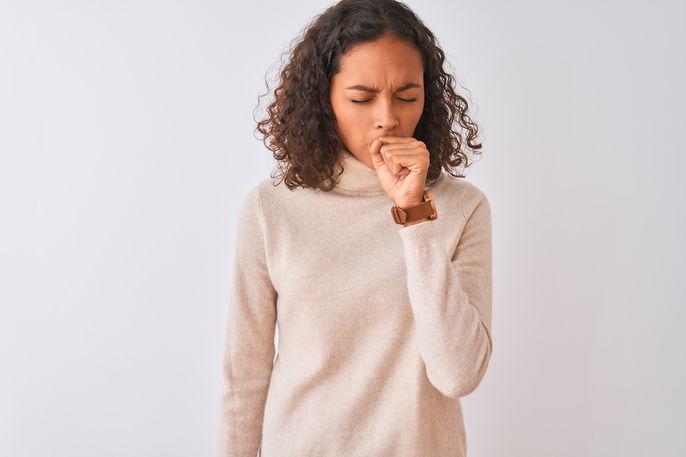The presence of phlegm, or sputum, is a sign of illness in the respiratory system. The most common causes of phlegm include respiratory allergies, a cold or a flu. These specific causes are usually associated with clear or white phlegm.
Phlegm color can vary, however, especially when there is an infection present. Infections usually cause a more yellow or green phlegm. It can also be blood-tinged, or turn red or pink.
No matter its color, you should consult your doctor if you have phlegm, especially if you have other symptoms like fever, chills or shortness of breath. Your doctor will identify the cause and initiate appropriate treatment.

The following is a list of the most common colors of phlegm and what they can mean:
1. Green or yellow phlegm
These colors of phlegm will usually emerge when there are neutrophils present in the airways. Neutrophils are defense cells of the immune system that produce a green protein that dissolves in phlegm. The intensity of yellow or green in the phlegm will vary depending on the quantity of protein produced. This color of phlegm is usually a sign of a respiratory infection, like pharyngitis or pneumonia
What to do: See your doctor for assessment to determine whether there is an infection present. If confirmed, antibiotics will likely be prescribed.
2. Phlegm that has blood or is red
When small specks of blood are seen in phlegm, is it generally a sign of bronchitis. However, large amounts of blood can be a sign of more serious problems, like tuberculosis, pneumonia or lung cancer.
What to do: Your doctor will likely refer you to a lung specialist. Exams that will probably be ordered in the meantime include X-ray and a sputum culture. These tests help to identify the problem so that appropriate treatment can be started. With bronchitis, bronchodilators are usually prescribed, while antibiotics are more commonly prescribed for tuberculosis.
3. White or gray phlegm
This type of phlegm is usually a sign of inflammation in the upper airways, but it can also occur with the flu. A sinus infection can also result in white or gray phlegm. This is due to the nasal sinuses becoming very full and draining to the throat.
In rare cases, this color of phlegm can also occur due to increased intake of dairy products. Dairy products can make phlegm thicker, and cause it to become whiter when coughed up.
What to do: You should drink about 2 L (about 8 cups) of water per day to help clear the phlegm. If you do not notice any improvement, you should see your doctor to identify the cause of the phlegm.
If this phlegm is caused by a flu virus, treatment is normally aimed at relieving the flu-related symptoms (e.g. using acetaminophen or ibuprofen). Sinus infections can also be treated with these medications, although antibiotics or corticosteroids may additionally be prescribed (depending on the type). Learn more about the different types of sinus infections and how they are treated.
4. Brown or black phlegm
Smokers and people who work in areas with poor air quality (like miners) will commonly have brown or black sputum. This phlegm occurs due to the presence of small particles (e.g. resin, asphalt, etc) that build up and become stuck together in the airways. Brown phlegm can also occur after consuming certain foods, like chocolate, coffee or red wine.
What to do: You should avoid going to dusty places or places with high pollution. Smokers are also advised to quit smoking.
5. Pink phlegm
Coughing accompanied by pink phlegm is usually a sign of fluid in the lungs. It is common in people with cardiac problems, like ventricular heart failure (when blood starts to accumulate in the heart and backs-up into the lungs)
What to do: You should be assessed by your doctor (or lung specialist or cardiologist if a heart issue has already been confirmed). If the phlegm is due to a heart problem, diuretics like furosemide may be prescribed.
Different consistencies of phlegm and what they mean
Normal and healthy phlegm usually has a more liquid consistency, which makes it easier to be reabsorbed in the body and does not affect breathing. Phlegm can become thick for many reasons, like:
- Dry environments, like an air-conditioned room
- Inadequate water intake throughout the day
- Respiratory allergies to pollen or dust
- Certain medications that can dry-out mucus membranes, like antidepressants, antihistamines or decongestants.
In addition, phlegm can become thicker if you have a cold, flu or any other infection. Because the body requires more water to help fight-off and eliminate a virus or bacteria, normally thin phlegm can become thicker.
To get rid of thick phlegm, you should ensure adequate fluid intake (about 2L or 8 cups of water per day). Nebulizers with water or saline can also help to free up thick mucus, which makes it easier to eliminate.






























